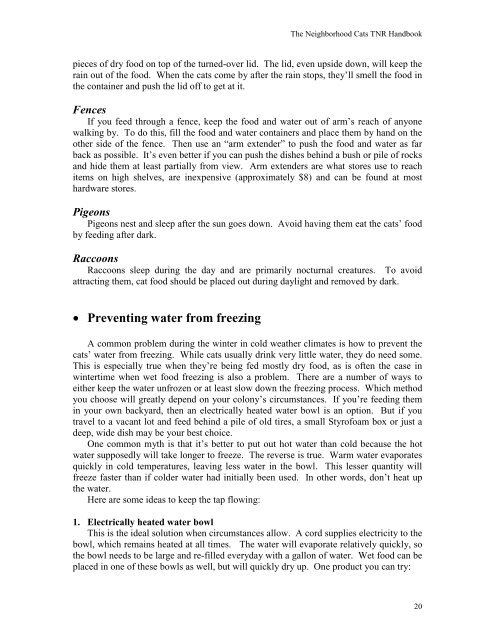Create successful ePaper yourself
Turn your PDF publications into a flip-book with our unique Google optimized e-Paper software.
The <strong>Neighborhood</strong> <strong>Cats</strong> <strong>TNR</strong> <strong>Handbook</strong><br />
pieces of dry food on top of the turned-over lid. The lid, even upside down, will keep the<br />
rain out of the food. When the cats come by after the rain stops, they’ll smell the food in<br />
the container and push the lid off to get at it.<br />
Fences<br />
If you feed through a fence, keep the food and water out of arm’s reach of anyone<br />
walking by. To do this, fill the food and water containers and place them by hand on the<br />
other side of the fence. Then use an “arm extender” to push the food and water as far<br />
back as possible. It’s even better if you can push the dishes behind a bush or pile of rocks<br />
and hide them at least partially from view. Arm extenders are what stores use to reach<br />
items on high shelves, are inexpensive (approximately $8) and can be found at most<br />
hardware stores.<br />
Pigeons<br />
Pigeons nest and sleep after the sun goes down. Avoid having them eat the cats’ food<br />
by feeding after dark.<br />
Raccoons<br />
Raccoons sleep during the day and are primarily nocturnal creatures. To avoid<br />
attracting them, cat food should be placed out during daylight and removed by dark.<br />
• Preventing water from freezing<br />
A common problem during the winter in cold weather climates is how to prevent the<br />
cats’ water from freezing. While cats usually drink very little water, they do need some.<br />
This is especially true when they’re being fed mostly dry food, as is often the case in<br />
wintertime when wet food freezing is also a problem. There are a number of ways to<br />
either keep the water unfrozen or at least slow down the freezing process. Which method<br />
you choose will greatly depend on your colony’s circumstances. If you’re feeding them<br />
in your own backyard, then an electrically heated water bowl is an option. But if you<br />
travel to a vacant lot and feed behind a pile of old tires, a small Styrofoam box or just a<br />
deep, wide dish may be your best choice.<br />
One common myth is that it’s better to put out hot water than cold because the hot<br />
water supposedly will take longer to freeze. The reverse is true. Warm water evaporates<br />
quickly in cold temperatures, leaving less water in the bowl. This lesser quantity will<br />
freeze faster than if colder water had initially been used. In other words, don’t heat up<br />
the water.<br />
Here are some ideas to keep the tap flowing:<br />
1. Electrically heated water bowl<br />
This is the ideal solution when circumstances allow. A cord supplies electricity to the<br />
bowl, which remains heated at all times. The water will evaporate relatively quickly, so<br />
the bowl needs to be large and re-filled everyday with a gallon of water. Wet food can be<br />
placed in one of these bowls as well, but will quickly dry up. One product you can try:<br />
20


